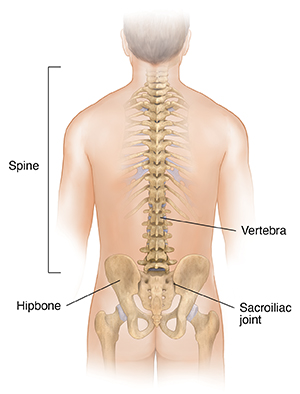Ankylosing Spondylitis in Adults
Arthritis is a disease that affects your joints. Ankylosing spondylitis (AS) is a type of arthritis. It causes swelling (inflammation) in certain parts of the spine.

What causes AS?
Healthcare providers don’t know exactly what causes AS. Genes may play a role. Many people with AS have a gene called HLA-B27. But only a few people with this gene actually get AS.
Young and old people can get AS. But it’s more common in people ages 17 to 35. Men are more likely than women to have AS. You are also more likely to have it if someone else in your family had it.
Symptoms
AS causes pain and stiffness. The spine and nearby joints such as the hip become irritated (inflamed). The disease may break down the joints in serious cases. Bones may even fuse together.
Symptoms of AS may come and go. They often include:
-
Back pain. This often happens in the morning when you wake up.
-
Body aches. These may be in the legs, shoulders, buttocks, or heels.
-
Stiffness in the morning
-
Stooped posture to ease pain
-
Problems breathing in deeply. This happens if AS affects the joints between the ribs and the spine.
-
Lack of appetite
-
Feeling very tired (fatigue)
-
Fever
-
Low red blood cell count (anemia)
Some people with AS also have skin rashes and stomach illnesses. They may also have eye problems. These include pain, redness, and sensitivity to light. Severe cases of the disease may damage the heart and lungs. About half of people with AS get weak and brittle bones (osteoporosis).
Diagnosing AS
To diagnose AS, your healthcare provider will start with a physical exam. They will ask about your symptoms and health history. X-rays of your spine and other joints may show joint damage. You may also have an MRI. Genetic testing can find out if you have the HLA-B27 gene.
Your healthcare provider may also advise a lab test to check for inflammation. The test is called erythrocyte sedimentation rate test. It shows how quickly red blood cells fall to the bottom of a test tube. The red blood cells will clump together and fall faster if you have inflammation from arthritis.
Treating AS
AS has no known cure. But you can manage it with certain treatments that can ease pain and stiffness. They can help you live a more active life. Your healthcare provider will choose the best treatment based on your overall health and how bad the disease is.
Several types of medicine can reduce pain and inflammation. These medicines include:
-
Nonsteroidal anti-inflammatory drugs (NSAIDs). Examples are naproxen and ibuprofen.
-
Corticosteroids. These can be injected into affected joints and areas.
-
Muscle relaxants
-
Biologic medicines
-
Disease-modifying anti-rheumatic drugs (DMARDs)
Alternative treatments may also help. Talk with your provider about acupuncture, massage, yoga, and TENS units (transcutaneous electrical nerve stimulation).
Quitting smoking may help.
Your provider may also advise surgery. For instance, you may need to have a joint replaced. Other procedures remove damaged bone or insert rods into the spine.
Exercising regularly can help ease your symptoms. Be sure to include activities that strengthen the back. Also do exercises that make you more flexible and extend your range of motion. Your provider may also suggest physical therapy. Using correct posture is also important.